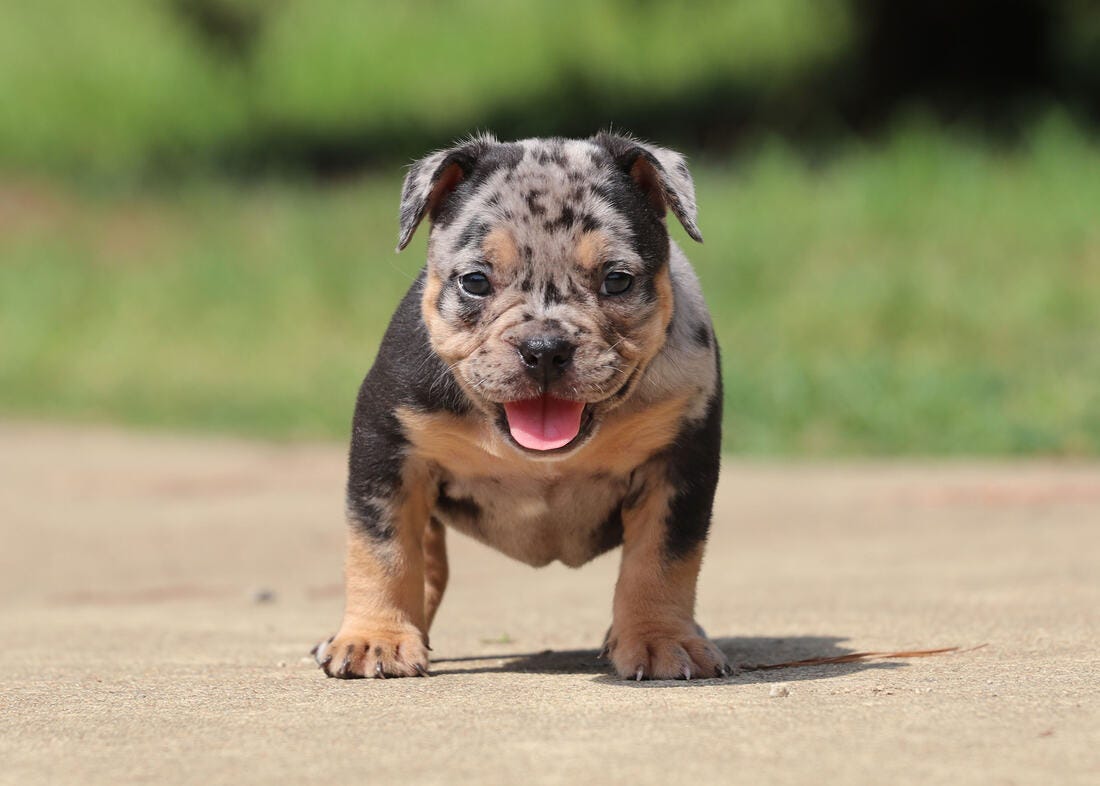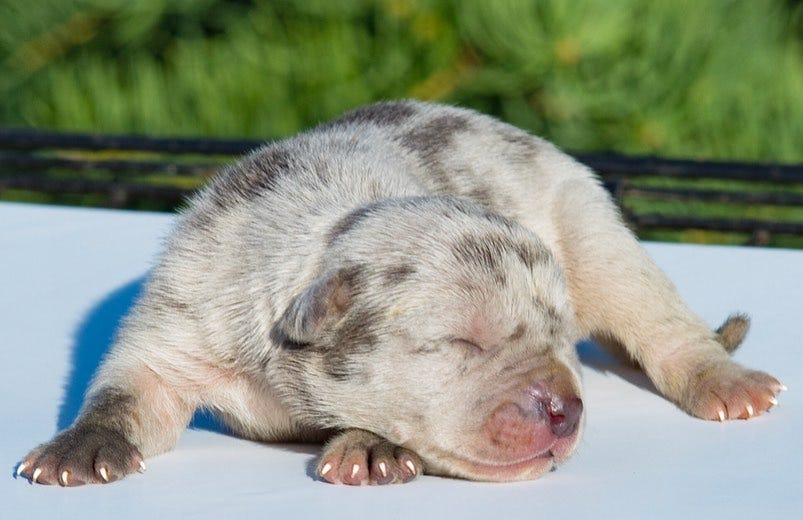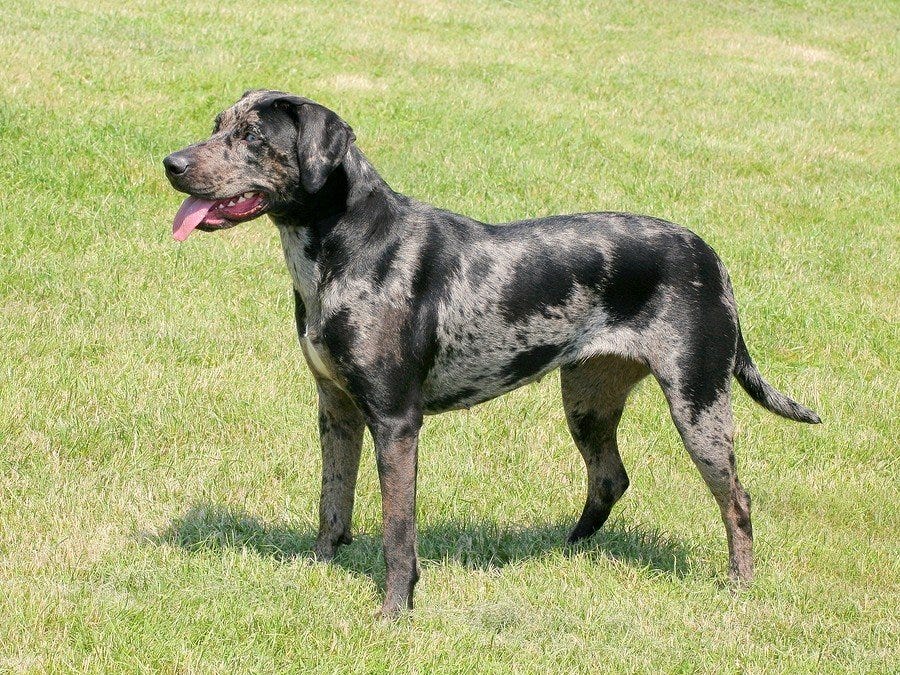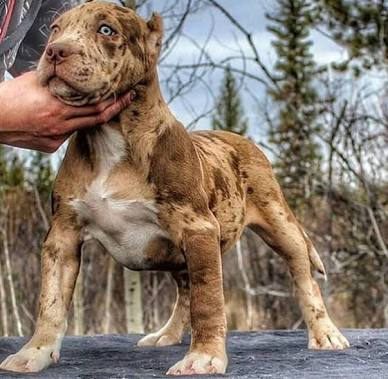The merle coat
In certain breeds of dog, there is a coat pattern known as ‘merle’. It is sometimes referred to as a color, but is in fact due to a gene that alters the way pigment appears in the dog’s coat. The merle coat pattern is popular because it is unusual and very unique, with each merle dog having a different coat pattern.
Unfortunately, there are health problems associated with the merle mutation and the risk of these problems occurring increases when two merle coated dogs are mated together. The resulting litter of puppies has a high chance of containing ‘double merles’ or ‘lethal whites’, dogs that have very little or no colour to their coat at all. Double merles are highly likely to suffer from eye or ear deformities (in some cases both), which at the most extreme can result in complete blindness and deafness.
Needless to say, the deliberate breeding of double merles causes a lot of controversy in the canine world — certain official bodies (such as the Kennel Club in the UK) have clamped down on the practice, refusing to register dogs that are a result of merle-to-merle breeding. This article explores the world of double merle genetics, the breeds affected, the health issues and the wide range of ongoing debates concerning the breeding of double merles.
WHAT IS A MERLE?

A dog with a merle coat is characterized by having patches of hair with diluted pigment (color). Though a variety of merle colors are referred to by breeders and dog owners, the two most commonly seen types of merle are blue merles and red merles. Blue merles are, in fact, grey. They appear like a tri-color dog (black, white and tan), but with patches of the black appearing ‘faded’ or grey.
Similarly, a red merle will have faded patches of red and will often look more mottled than the blue merle. While all of the breeds with the merle coat pattern produce blue merles, only certain breeds produce red merles. The strength of the other colours in the dog’s coat (tan and black, or red and tan) can vary as well, with some merles appearing to have extremely pale colouring all over, while others can have quite strong patches of colour. Blue merles with no tan markings at all are known as bi-blues, but a red merle does not necessarily have to have tan markings.
Merles commonly have blue eyes. Sometimes they have one blue and one brown eye. They can also, on occasion, have two brown eyes. Sometimes dogs may appear to have normal coat colouring but are in fact merles and will produce puppies with the merle colouration. These are known as ‘cryptic merles’, but the exact reason why such dogs do not display the merle pattern remains unknown.
The merle gene is usually dominant, so a merle dog will have inherited the gene from one of its parents. While a non-merle dog (unless a cryptic) will have inherited no merle gene.
For example, in a litter of mixed colour puppies the non-merles will be (mm), while a merle will be (Mm), meaning it has inherited one merle gene and one non-merle gene.
HEALTH PROBLEMS ASSOCIATED WITH THE MERLE GENE
There is scientific evidence to suggest that the merle gene may be linked to a higher rate of ocular (eye) or auditory (ear) problems. A 2006 paper on the merle gene first published by the National Academy of Sciences of the United States of America attempted to identify the gene in dogs that caused the merle pattern.
Among their findings they recorded research on deafness in Dachshunds with the merle gene. One study reported 36.8% of Dachshunds with the merle coat pattern (Mm) suffered hearing problems ranging from mild to complete deafness. While none of the control group of non-merles (mm) had any hearing issues.
Another study found that merles had a “significantly greater” frequency of eye abnormalities than non-merles. Other studies cited by the article found that the merle gene was associated with skeletal, cardiac and reproductive abnormalities, but there is far less conclusive evidence for this.
THE DOUBLE MERLE

The merle pattern is produced when a dog has a single copy of the M< allele. All merle dogs have the genotype Mm — meaning they have one allele for merle and one allele for non-merle. All non-merles are mm. If you breed a merle (Mm) to a non-merle (mm) you will on average produce a litter in which a half of the puppies get the M allele so are Mm (merle) and half get the non-merle allele so are mm.
But if you breed two merles together (Mm X Mm) you will produce on average a quarter mm (non-merle), a half Mm (merle) and a quarter MM (double-merle; also called double-dapple). And double merles don’t look like merles. Instead, they’re mostly white with merle patches. But the main reason you want to avoid producing MM dogs is that they often have visual and auditory problems.
A double merle is created when two merle dogs are bred together. It doesn’t matter what color merle or what breed they are. If two merle dogs are bred together, each puppy in the litter has a 25% chance of being born a double merle.
BREEDS IN WHICH THE MERLE COAT IS ACCEPTED

The following breeds carry merle and are recognized by the AKC as an acceptable color: Australian Shepherd, Border Collie, Cardigan Welsh Corgi, Catahoula Leopard Dog, Chihuahua, Cocker Spaniel, Collie (rough or smooth), Dachshund (called dapple), Great Dane (harlequin acts the same), Mudi, Old English Sheepdog, Pomeranian, Pyrenean Shepherd, and Shetland Sheepdog.
The merle gene is being introduced into new breeds everyday. Merle is now present in Poodles, Bulldogs, American Staffordshire Terriers, American Pit Bull Terriers, American Exotic Bullies and Australian Koolies. It’s becoming more prevalent in many of the newer “designer breeds.” There is an overabundance of these dogs and it’s truly heartbreaking. There are rescues all over the country that are committed solely to rescuing these dogs, that should speak volumes in itself. These dogs are 100% preventable. Don’t breed two merle dogs, and you won’t have double merles.







Comments
Post a Comment